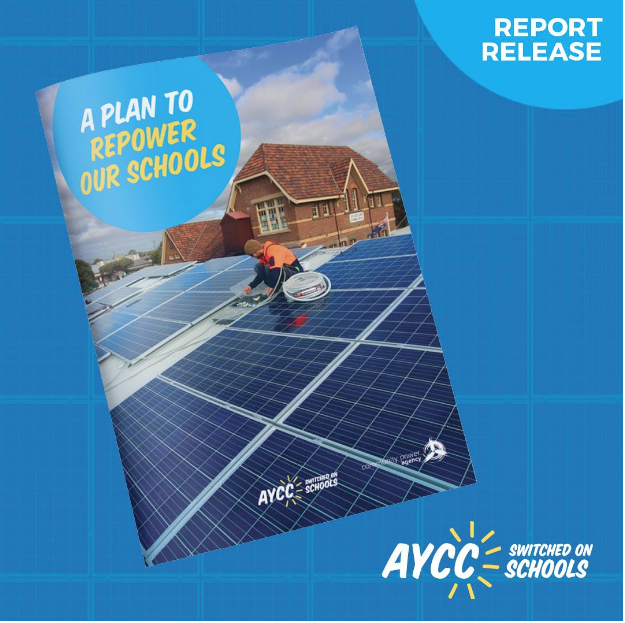Thousands of Australian school students finished 2018 with #Strike4climateaction protests against Government refusal to address climate change. Their holidays have been scorching, underscoring the effects of burgeoning carbon emissions on environmental conditions. On Tuesday 29 January, New South Wales and Victoria commence the 2019 school year with an encouraging resource: a costed, step-by-step plan for transitioning their high schools to 100% renewable energy.
A plan to repower our schools shows how NSW’s 519 public high schools and Victoria’s 418 public high schools can install rooftop solar PV to save a collective annual $16.4 million on energy — money that can be ‘recycled’ into educational opportunities; reduce schools’ carbon emissions; and help students learn first hand about the economics of energy as they drive change.
Laura Sykes, Schools Program Director with the Australian Youth Climate Coalition (AYCC), says, “We believe that young people aren’t the leaders of tomorrow, they’re the leaders of today.” If they’re equipped with knowledge about climate change and the skills to take action, says Sykes, “they can change the world”.
In the introduction to A plan to repower our schools, she hails the achievements of South Australian high school students who successfully lobbied their state government to implement a $15 million Solar Schools program in 2016. Under that program more than 40 schools received $250,000 each to fund installation of solar panels and implementation of energy-efficiency measures.
The cheapest and cleanest energy is the energy we don’t use
The first steps outlined in the Repower our schools program for NSW and Victoria include a fact-finding audit of each school’s energy-consumption patterns, using smart meters and an online energy data portal to analyse usage and inefficiencies.
The plan then provides for 100 kW of solar PV panels to be installed on every public high school across the two states, at a combined cost of $128 million, which includes government procurement, project management, installation and quality assurance.
Authors of the program, Nicky Ison, a Founding Director of the Community Power Agency, and Taegen Edwards a climate-change policy adviser and researcher now working with Solar Citizens, acknowledge that many schools across Victoria and NSW have small solar systems installed as a result of the Federal Government’s National Solar Schools Program (July 2008 to June 2013) and various state government initiatives. But they note that these systems have an average capacity of around 5 kW per school in NSW and 7 kW in Victoria, which powers around 2% of their needs.
The Repower our schools proposal to install 100 kW systems will reduce the demand high schools place on the grid in each state by around one-third.
In New South Wales, the 72 gigawatt hours (GWh) of clean solar energy produced each year would save 60,000 tonnes of carbon-emissions (equivalent to taking some 13,000 petrol-driven vehicles off the road), and $7 million in energy bills.
In Victoria, the annual solar output of 50.5 GWh would reduce climate-changing emissions by 54,500 tonnes (equivalent to taking 11,500 cars off the road), and save $9.4 million a year, which can be reinvested in “climate change and clean energy education”, propose Ison and Edwards.
Repower equals steady repayments and rewards
That is, they suggest that each school retain the savings made by implementing solar systems to fund educational initiatives. The governments will benefit from energy-efficiency measures identified during the audit phase of school energy use, and implemented with proceeds from a School Energy Efficiency Revolving Fund ($20 million in NSW and $17 million in Victoria) which would be paid back over time, from the savings made.
A plan to repower our schools advocates that the remaining 66% or so of high-school energy demand in NSW and Victoria be met by respective state governments negotiating power purchase agreements (PPAs) with renewable-energy providers. When current state energy contracts are close to renewal, say Ison and Edwards, the relevant Department of Education “should enter into a PPA with a large-scale renewables project, ideally a project that showcases multiple renewable technologies,” such as solar and wind, plus battery or pumped-hydro storage.
The authors include numerous opportunities for student learning about the clean-energy economy within the plan’s implementation and costing, saying, “We need to upgrade the clean-energy curriculum with new modules and teacher training,” so that schools can then “spread the sunshine by working in their communities to increase energy efficiency” and develop local clean-energy initiatives.
Cost estimates and payback periods are calculated in detail, providing NSW and Victorian governments with a considered plan for meeting student aspirations for more renewably powered lives, and enacting meaningful change in carbon emissions.
Northern Territory schools are also set to receive a renewable boost to their fortunes starting this school year, under the Territory’s three-year Roadmap to Renewables plan announced in December, which includes $5 million earmarked to install solar PV on up to 25 schools and cut energy bills by as much as 40%.
For climate-change-aware students, a roadmap to 100% renewable power for schools would seem a smart start to regaining their trust in the political will to safeguard their future.
As much-quoted teenage Swedish climate activist Greta Thunberg wrote in the Guardian Australia on 27 November, “why should any young person be made to study for a future when no-one is doing enough to save that future? What is the point of learning facts when the most important facts given by the finest scientists are ignored by our politicians?”
This content is protected by copyright and may not be reused. If you want to cooperate with us and would like to reuse some of our content, please contact: editors@pv-magazine.com.









I have often wondered why this hasn’t been done years ago! It’s a great step forward.